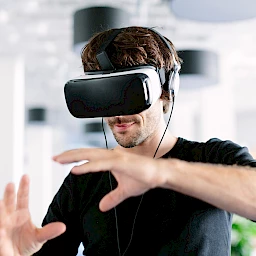The world of work is changing. Artificial intelligence and innovation are advancing and digital space is also making its space into companies. How are these trends affecting workspaces? An interview with technology strategist Jay Latta (in two parts).
Many companies are taking their inspiration from Silicon Valley, not only in terms of innovation, but also in terms of establishing new structures in the world of work. How do you see this trend?
Silicon Valley is seen by many as a role model for technological innovation and future viability. With this approach, however, we hide behind a constructed aura and cover up our own magic. Silicon Valley is above all a mindset with a strongly progressive approach. But it cannot simply be transferred to other regions or countries. Let’s take a look at New Work in Germany: here, we are forcing agile structures into corporate settings, but we don’t have the organisational framework for it. My old team leader suddenly becomes my product owner. The old group manager is now the line manager and no longer technically responsible, but the person responsible for human resources. There are also scrum managers and other functions, in other words: the complexity of organisational structures increases. In a team of seven, for example, just four people suddenly work. The rest only have one function. And we no longer report to just one boss, but have to submit bi-weekly, bi-quarterly, quarterly and other reports. These structures create a greater decoupling from our work and thus an irritation. The new structure and the new roles lead to the fact that no one understands his or her job any more.
What kind of culture does agile work require?
Agile working is about giving people autonomous tasks for which they are personally responsible. Leadership has to be aligned with the question “How can I make my employees happy?” and corporate culture has to change in the sense that people can fulfil the three Ps – purpose, passion and pleasure – when working. In companies, however, the reality is often completely different. There needs to be a shift away from degrees, certificates and credentials to tasks that match employees’ skills and passions. Why shouldn’t a warehouse worker be able to participate in a 3D printing project if he has the necessary knowledge?
„New Work ist super interesting. Let´s see how we mess it up again.“ Jay Latta
What space does innovativeness need in the world of work?
First of all, we overestimate ourselves in terms of innovation. We are engineering, we are continuous improvement, we are basic research. But we are neither creative nor innovative in Germany. Why is that? For a start: Innovation needs necessary spaces. In architecture, we distinguish between hard and soft spaces. Soft space is something I can design. It used to be my office, where I had pictures of my family and everything else that inspired me. I could design my working area to either protect me or inspire me. The hard spaces are spaces I have to be in and where I have no creative freedom. With the New Work environments from Silicon Valley, our workspaces have also changed. Soft spaces were eliminated and with the clean desk policy, people were even more deprived of the possibility to separate or inspire themselves at work. Today, employees are increasingly driven in an internal efficiency to have less and less personal space at the workplace. As a result, however, people often just feel like they are in a kind of work factory and disconnect themselves from creativity and the ability to innovate.
There is another aspect: the initiative to set up innovation units in companies detaches employees from the actual innovation process and deprives them of spaces to contribute their experiences and ideas to creative processes. These structures suggest to experienced employees ” Do your job, innovation is handled by the cool guys in skinny jeans with white sneakers and undercut”. This decoupling of the rest of the company from innovation ignores who you are dealing with. Unfortunately, the management often fails to see the problem.
Please also read

What benefits do the new, virtual spaces bring and does the metaverse have the potential to be an alternative workspace?
The metaverse, that is always talked of, is often misused and misunderstood. It is not NFTs or some crazy monkeys. If you look at its origin, namely the novel Snow Crash by Neal Stephenson, the metaverse is a connectivity layer that links different verses together. The metaverse is a data pool.
If we want to immerse ourselves in the working environments, we need the immersive space, the so-called XR. Virtual Reality, Augmented Reality, Mixed Reality etc. Visualisation is the tool to understand the overload of data. That is the real magic. If companies implement virtual spaces correctly and have the right philosophy behind them, they are extremely important in the world of work. The benefits of virtual space are manifold. For one, it supports remote work and takes away people’s stress. But virtual space also offers them safe places, “safe spaces”, in which they can exchange ideas without being observed and afraid.
Read part 2 of the interview with Jay Latta here.





